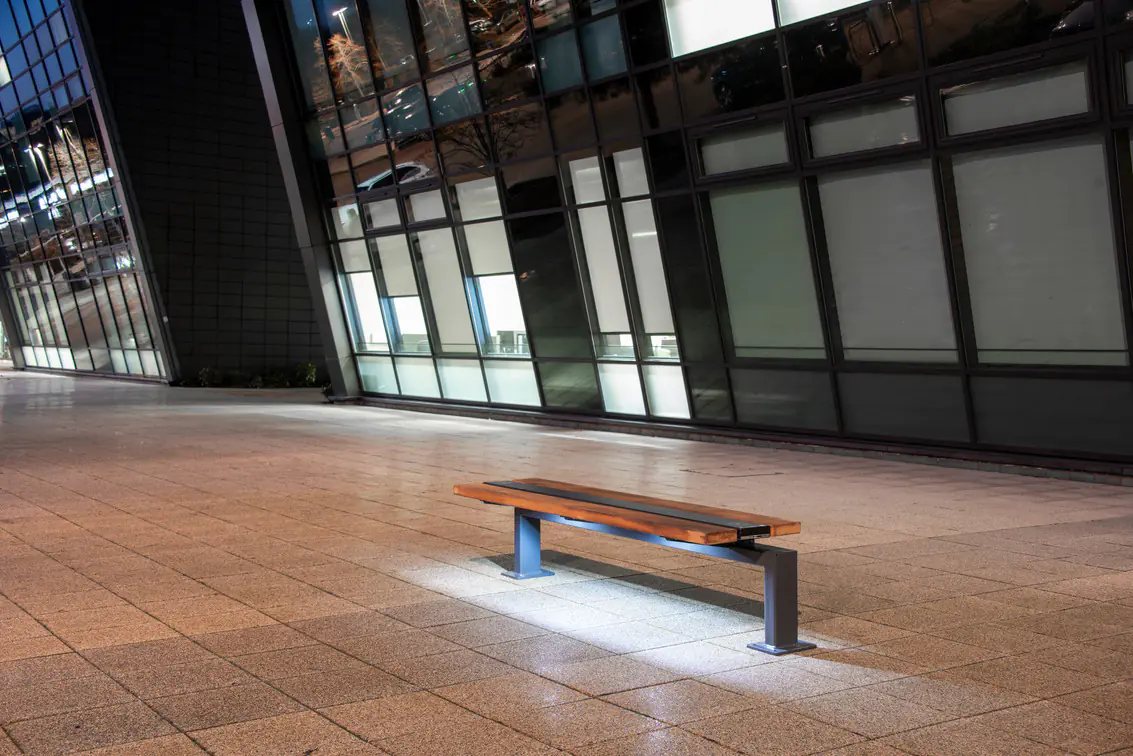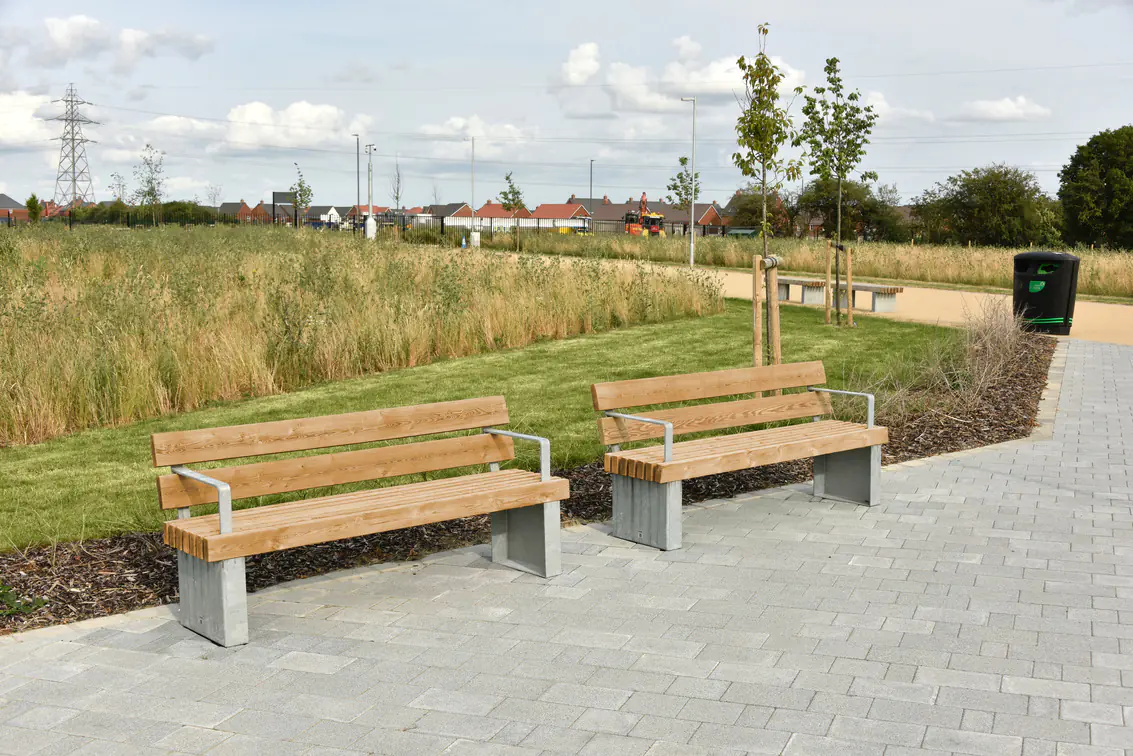Benches Buying Guide
Benches may seem like simple objects, but they play a powerful role in shaping how people interact with public space.
Whether it’s a quiet park, a bustling city street, or a transit stop, well-designed benches offer more than just a place to sit, they encourage connection, rest, and a sense of belonging.
At Broxap, we’ve spent decades manufacturing outdoor furniture that not only stands the test of time but also reflects the communities it's built for. With this guide, we’re sharing our insights to help you select the ideal bench for your setting.
Let’s dive into what makes a bench more than just a seat.
Outdoor Bench Types
The right bench depends on the space, the people using it, and the demands of the environment.
Benches come in a variety of styles, each designed to suit specific environments and uses. Backless benches are commonly used in high-footfall areas or narrow walkways where flexibility and space-saving are important.
Benches with backs offer more support and comfort, making them ideal for parks, town centres, and waiting areas where people are likely to sit for longer periods.
The inclusion of armrests can improve accessibility, especially for older users, though some designs exclude them to allow for greater seating flexibility. In social or high-traffic areas, modular benches are popular for their ability to form longer runs, curves, or clusters that encourage interaction.
Material and design often reflect the setting. Full timber benches are typically chosen for parks and playgrounds, especially in more affluent areas. In contrast, all-steel benches are preferred in locations where vandal resistance is key, such as bus and train stations. Heritage sites and parish councils often require cast iron for its traditional look, while urban developments lean towards modern designs in powder-coated steel or stainless finishes.
The right bench depends on the space, the people using it, and the demands of the environment.
Materials
Over time, we've seen clear trends emerge in what materials perform best, where they belong, and how they age in public environments.
Here’s a breakdown of the most common materials we work with, their pros and cons, and guidance on where each one shines.
Timber
Iroko hardwood is, without question, our most popular material, and for good reason. Sourced from tropical West Africa, Iroko is a dense, durable hardwood that naturally withstands the elements without the need for chemical treatment or surface staining. Once planed and sanded, we leave it bare, allowing nature to take its course. Over time, the wood develops a silvery patina while retaining its structural integrity.
A great example of its longevity? We have timber benches installed in Burslem Park that are now over 15 years old and they’re still as sound as the day they were installed.
Iroko is also highly versatile: we use it on mild steel frames, cast iron supports, and even concrete bases. It’s often preferred in parks, playgrounds, and high-traffic areas where durability is essential.
Note: For use with concrete bases, we seal the timber to prevent natural sap leaching, which can occasionally occur as the timber dries.
Features of timber:
- Self-finishing (no stain needed)
- Long life expectancy
- Strong resistance to decay and weathering
- Aesthetic appeal that improves over time


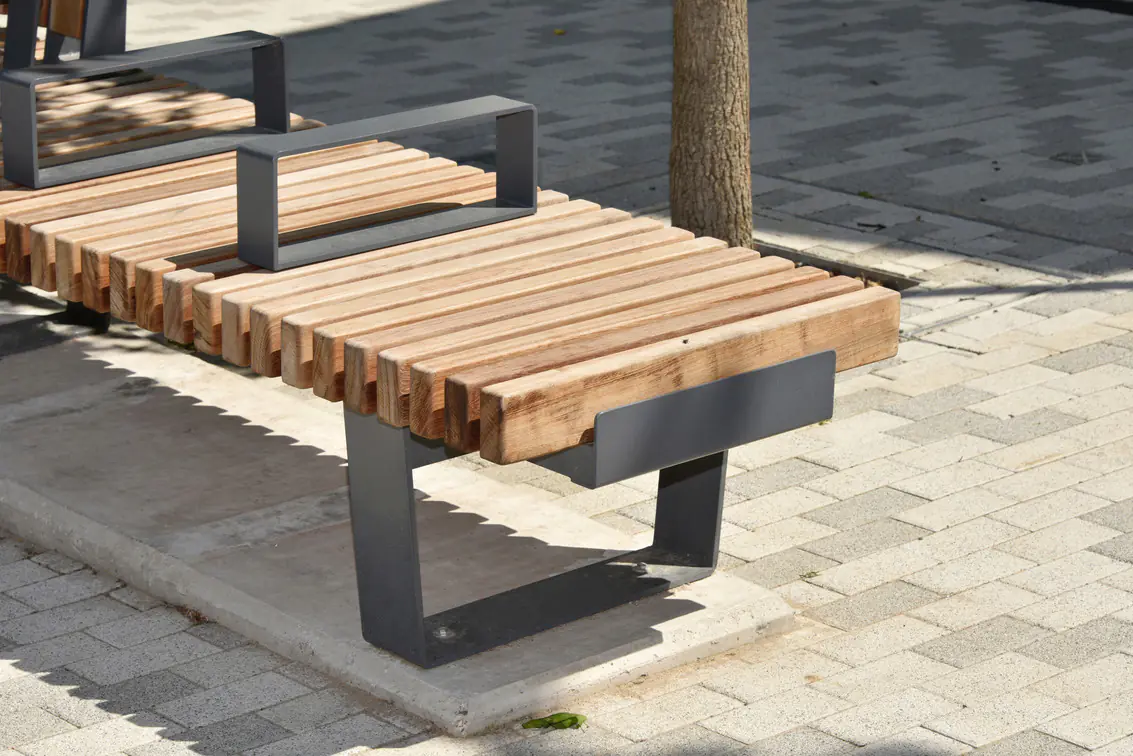

Mild Steel
Mild steel framed benches are ideal for contemporary schemes and tight budgets. Powder-coated in RAL 7016 (Anthracite Grey), they deliver a clean, modern look that’s become synonymous with urban streetscapes. The Litchard bench is a great example of this, simple, robust, and offered at nearly a third of the price of similar options.
For areas with high footfall, like bus and train stations, mild steel is often the go-to. It’s difficult to vandalise, can’t be easily damaged or removed, and is highly resistant to wear and tear.
Features of mild steel:
- Lower cost than cast iron or stainless steel
- Customisable with powder-coating (most popular: RAL 7016)
- Excellent for modern settings
- Tough, low maintenance
Cast Iron
When it comes to conservation areas, heritage sites, or parish council projects, cast iron remains the material of choice for benches. It aligns with British Heritage aesthetics and is often a requirement in listed or sensitive historic environments.
We frequently pair cast iron with Iroko timber slats for a classic, long-lasting combination. While more expensive than mild steel, cast iron benches are built to last and built to belong in historic settings.
Features of cast iron:
- Authentic heritage appeal
- High durability
- Pairs beautifully with hardwoods like Iroko
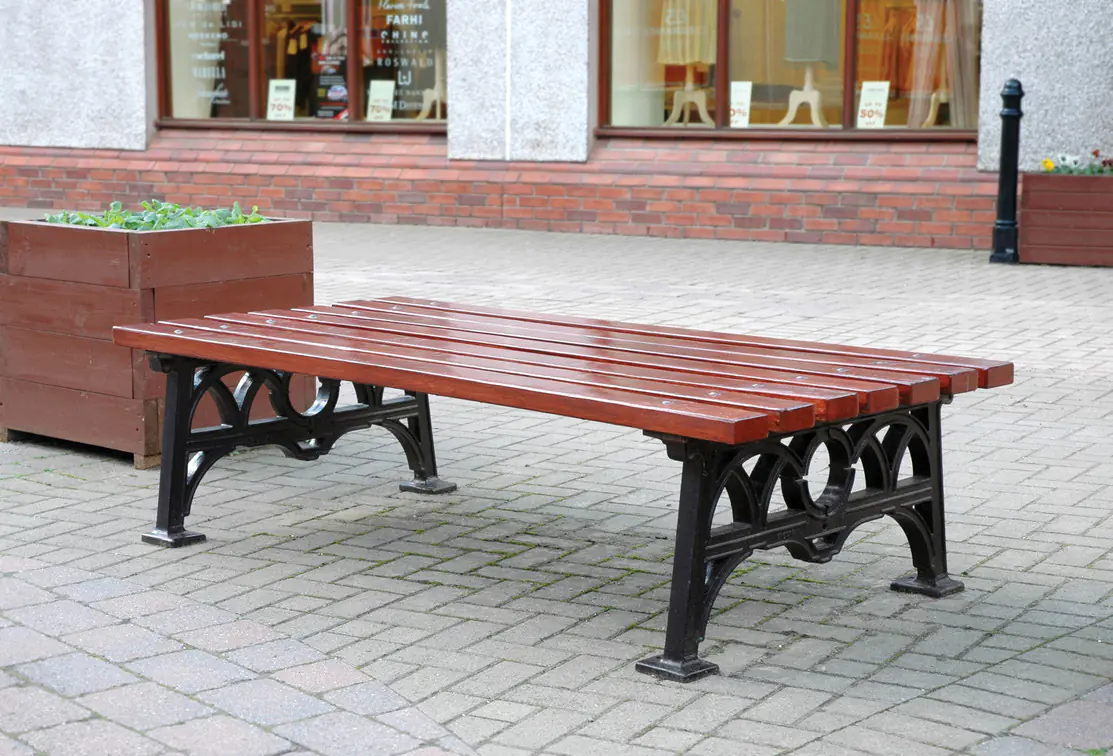

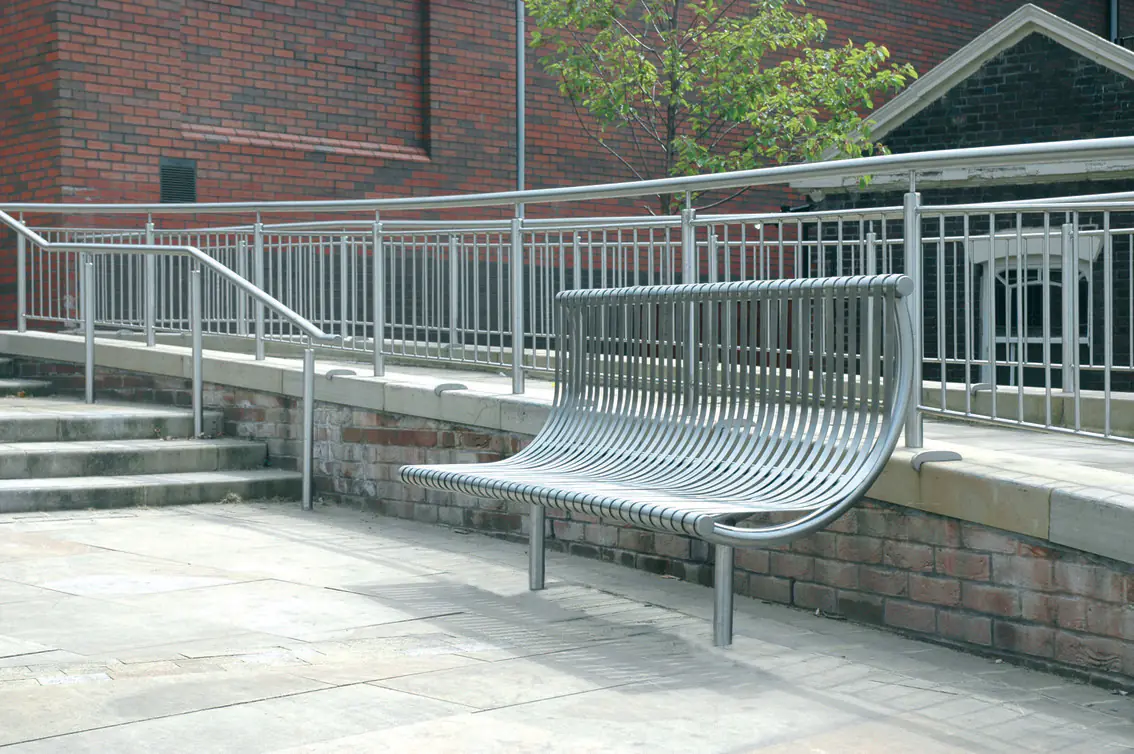

Stainless Steel
Stainless steel benches offer a sleek, architectural look, often paired with timber slats or used as fully stainless units. While they’re a popular request, stainless options tend to fall outside budget for many projects. When budgets are tight, clients often pivot to powder-coated mild steel for a similar effect at a lower cost.
Still, if you're aiming for a high-spec finish, especially in prestige commercial or waterfront environments, stainless is hard to beat. It’s naturally rust-resistant (not rustproof) and, while surface stains can occur, they can be polished out easily.
304 grade stainless is suitable for inland applications; while 316 grade stainless is a must for coastal areas (within 0–5 miles of saltwater), thanks to increased molybdenum content that resists corrosion from salty air.
Features of stainless steel:
- Sleek, modern aesthetic
- High resistance to corrosion and staining
- Long lifespan
Concrete
Concrete benches are a long-term investment, often lasting 50-100 years with little maintenance. They're particularly suited to large public realm schemes, urban parks, and contemporary mixed-use developments. Concrete’s weight, permanence, and modularity also make it ideal for creating natural flow, seating clusters, or demarcation zones.
We work with both UK-based manufacturers for custom projects and European partners like Calzolari, known for cost-effective designs. However, imported options can become cost-prohibitive due to shipping and handling, often making UK manufacturing the smarter long-term choice.
Concrete benches are often paired with timber tops, but these must be sealed to prevent staining from sap and tannins naturally present in Iroko.
Features of concrete:
- Extremely durable and long-lasting
- Surface-mounted installation (no groundworks required)
- Modular, flexible for design layouts
- Great for high-traffic and vandal-prone areas
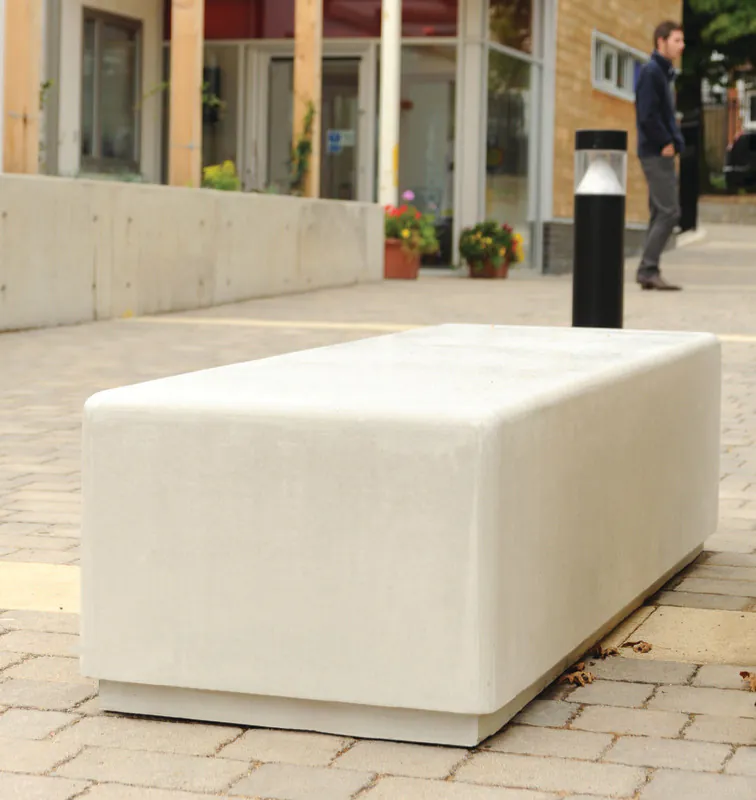

Hybrid and Composite Materials
Some of our most popular bench designs use a blend of materials. For example, our Hemstone Bench has a 30% granite base with steel and timber detailing. These hybrid solutions provide the best of all worlds: weight and permanence from stone, warmth and comfort from timber, and structure from metal.
These designs are especially popular in high-visibility locations where design impact and resilience need to coexist.
Bench Material Overview
| Material | Best For | Estimated Lifespan | Vandal Resistance | Budget Level |
| Iroko Timber | Parks, Playgrounds, Heritage and Premium Sites | 15-30+ years | Moderate | Medium-High |
| Mild Steel | Urban areas, transport hubs, tight budgets | 10-25 years | High | Low-Medium |
| Cast Iron | Heritage and conservation areas | 20-40+ years | High | High |
| Stainless Steel | Modern urban spaces, coastal settings | 25-40+ years | High | High |
| Concrete | Urban parks, civic spaces, high- traffic zones | 50-100 years | Very high | Medium-High |
| Composite/Granite | High-design, premium urban environments | 20-40+ years | High | Medium-High |
Coastal Protection
Salt in the air, high humidity and constant exposure to the elements can quickly break down materials if they’re not properly treated. That’s why we take coastal protection seriously, and we’ve learned through years of experience exactly what works.
If a bench is going anywhere within five miles of the sea, we always use a zinc-rich primer. It’s not optional. This primer acts as a crucial barrier between the metal and the salty air. Mild steel, which we often use for its strength, needs extra protection in coastal area, which is why we use a three-step process.
Each layer plays a role, but the zinc primer is what makes sure the outer layers stick properly and hold up over time. Without it, saltwater can creep in, even on a microscopic level, and start the rusting process underneath. The zinc-rich primer helps to stop that from happening.
Material choice also makes a big difference. Marine-grade stainless steel (like grade 316) is built to resist corrosion and is ideal for salty, wet environments. Recycled plastic and composite materials are also great, they don’t absorb water, and they won’t rot or rust. For wooden benches, we stick with dense, naturally oily hardwoods like Iroko or teak, which can handle the weather without needing extra treatment.
In short, we’ve done the research, we’ve seen the results, and we’ve built our coastal protection methods to last. Whether it’s steel, plastic, or timber, we use the right materials and coatings to make sure your benches stay strong and look good.
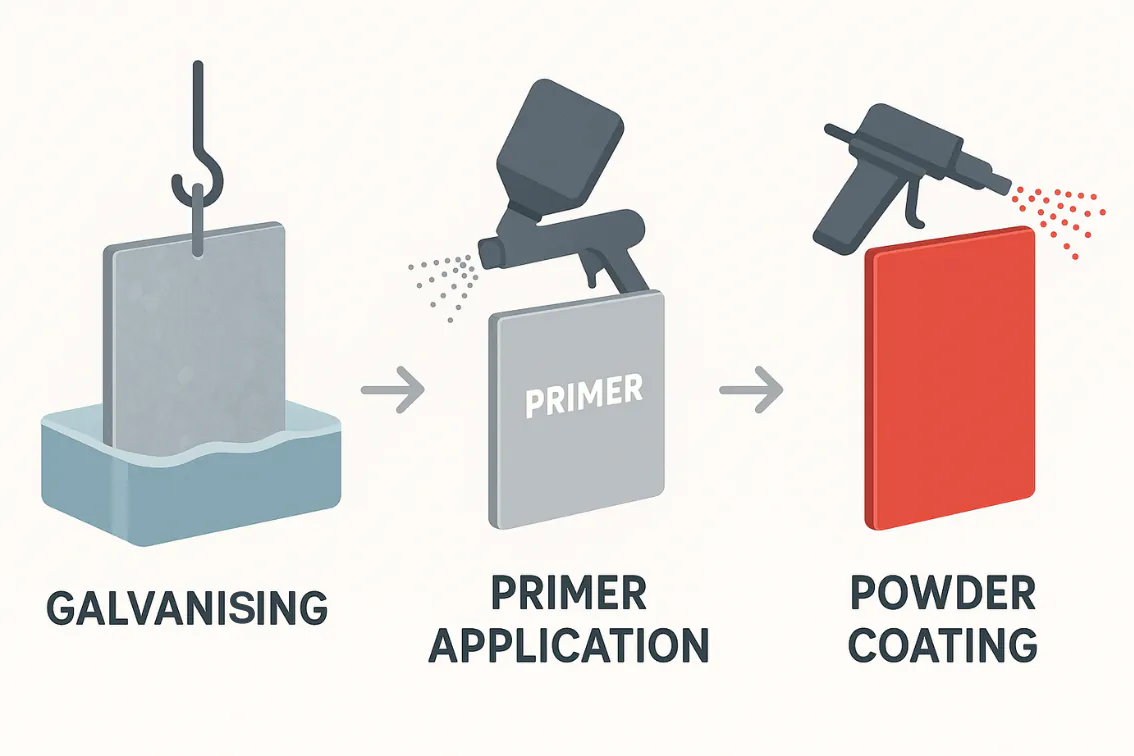

Our Costal Experience Story
We’ve seen what coastal weather can do, so we don’t take chances.
Years ago, we completed a coastal post-and-rail job using PU posts and mild steel panels. Everything looked great on day one, but within a week, the paint on the panels began to peel. The salt air had started to corrode the steel beneath the coating, and we quickly realised something was missing: proper protection for coastal conditions.
Rather than see it as a failure, we treated it as a learning opportunity. We began testing, researching, and working with experts to find a solution. That experience taught us how critical it is to coat steel the right way, especially near the sea.
What we learned then is now standard practice. Every coastal job we do includes a zinc-rich primer beneath the powder coat, no exceptions. Even though the story still makes some employees shudder all this time later, it’s proof that some challenges can lead to better, longer-lasting solutions.
Fixings


Surface Bolted
The bench is placed, marked, removed, holes are drilled into a concrete foundation, and then the bench is bolted down using four fixings, one at each leg.


Root Fixed
Legs are submerged 300mm into a concrete foundation, which is typically dug to around 400mm. Timber blocks are used under the legs during installation to level.


Submerged Baseplate
Fixing is set 100mm below the surface into a concrete base. Paving flags are laid around it for a clean appearance. Offers a neat finish with hidden fixings.


Surface Mounted
Some timber benches with four legs can be placed directly on a surface and are considered to be surface mounted*. Best suited to lighter designs.
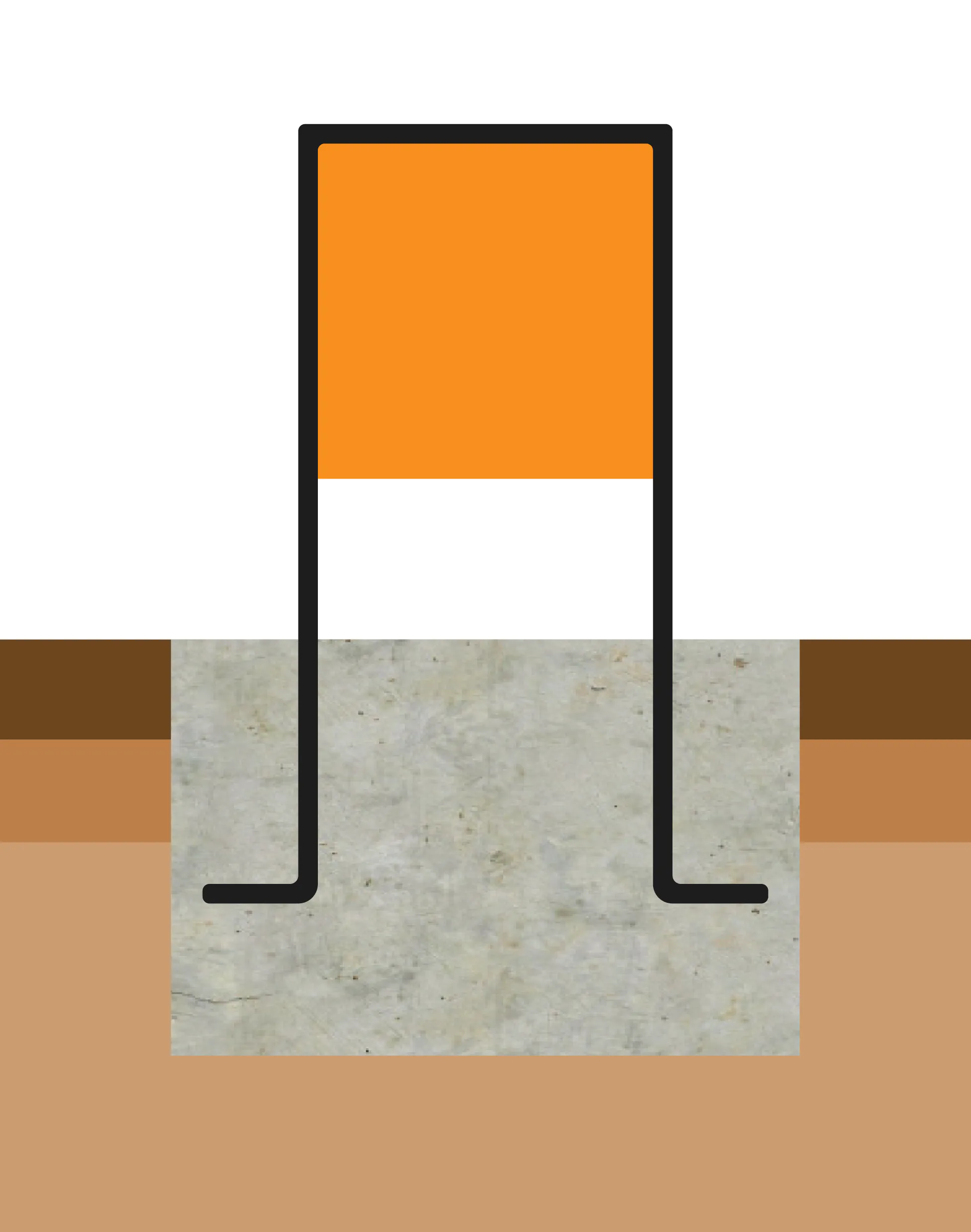

Stainless Steel Straps
Traditional timber benches use stainless steel straps to fix to the ground. Drilling directly into small timber sections is avoided, as it could compromise the wood.
*For safety reasons, we always recommend using appropriate fixings for any surface-mounted seating.
The impact of vandalism
Benches are places where people pause, relax, and connect. Think about it: when you stop for a coffee or take a break, where do you sit? Not on the floor or the kerb, but on a seat designed just for that purpose.
Along with bins and bollards, benches are carefully planned and placed to create welcoming, functional public spaces. They’re not random; every element serves a role in making outdoor areas comfortable and accessible. Damage not only ruins the look of these shared spaces but also disrupts their purpose, making it harder for people to enjoy a simple moment of rest or community.
To help protect benches from vandalism, we offer a range of anti-vandal options designed to keep seating safe and durable in public spaces. This includes selecting tough, resilient materials, such as a bench with a cast iron frame and steel slats, rather than timber slats.
We’ve never had a comeback on any of our antivandal seats.
We can also use tamper-resistant fixings to prevent removal or damage, making it much harder for benches to be vandalised or stolen. Benches can be installed using secure root-fixed methods, embedding the legs deep into concrete foundations to help ensure they remain intact and functional.
Sustainability and FSC timber
Sustainability is something we care deeply about, especially when it comes to the timber we use. In an ideal world, every piece of timber would be FSC-certified.
The Forest Stewardship Council (FSC) provides a full chain of custody, from the forest to the mill, onto the boat, through the port, and back again, ensuring that for every tree harvested, another is planted in its place. This level of traceability is what sets FSC apart.
However, not all timber on the market is FSC-certified. Some is classed as ‘responsibly sourced’, which means it’s been managed with care and according to good environmental practices, but without the official certification. This timber may follow the same principles, but it hasn’t been formally audited by the FSC or another governing body. In many cases, it can be a mix (some FSC timber, some not) which makes traceability less reliable.
At Broxap, we aim high, but we also have to be realistic about the conditions we work in. Not every project has the budget for FSC-certified materials, and in certain areas, insisting on FSC could price us out of being competitive altogether. That’s the difficult balance we face.
When a customer chooses certified timber, we know exactly where it came from and how it was managed. Still, we continue to provide responsibly sourced timber as an option, because the industry, and cost, sometimes demand it.


Regulations and best practices
While much of the legislation and guidance may not directly mandate specific bench configurations, these standards provide a framework to ensure that public seating is safe, usable, and equitable for all.
One of the most relevant documents is BS 8300-1:2018, the British Standard that sets out best practice for designing the built environment for accessible use. Although not a legal requirement in itself, BS 8300 is widely regarded as the benchmark for inclusive external spaces. For public benches, it covers critical design considerations such as seat height, armrest support, transfer spaces for wheelchair users, and features that assist people with visual impairments. For example, benches should typically include armrests that extend most of the seat depth to aid standing and sitting. Adequate spacing between seating elements should be factored into any layout, especially where benches are placed near accessible routes.
The Building Regulations Part M (Access to and Use of Buildings) is a legally binding framework in the UK that applies to new non-domestic buildings. While its guidance on seating is more limited than BS 8300, compliance can help demonstrate that a development meets its basic accessibility obligations.
Beyond national standards, designers and specifiers should be aware of emerging international frameworks like the European Accessibility Act (EAA). Although the UK has formally left the EU, much of its accessibility guidance has been retained in UK law.
While there is no single mandatory performance standard for bench strength in the public realm, buyers should always aim for seating solution that balance performance, comfort, and accessibility.
Future Trends
As public spaces adapt to changing needs, there’s a growing interest in integrating technology into street furniture. One exciting development is SmartBeam, a solar-powered addition that enables wireless connectivity, making benches points of interaction and connectivity. Whether it’s charging devices, accessing Wi-Fi, or enhancing public safety, people are increasingly intrigued by the idea of tech-enhanced environments.
As expectations shift, outdoor seating is another unexpected addition to the world of digital landscape.
